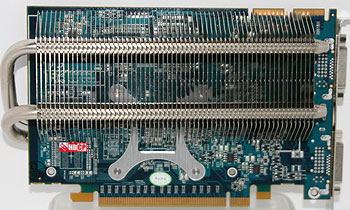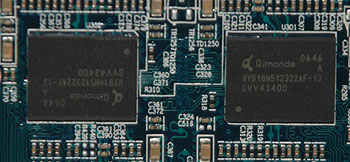Sapphire Ultimate Radeon HD 2600 XT
The Ultimate Radeon HD 2600 XT runs at 800/700 core/mem, 100MHz short of the reference board we tested in terms of the memory clock, using Qimonda 1.3ns devices running slower than their 770MHz rating.
The passive cooler moved heat from the GPU to the rear via heatpipes, where airflow over the fins is set to carry it away out of your chassis. The design is such that the fin orientation is perpendicular to probable case airflow, though. So rather than air flowing nicely across all fins in most chassis, it'll just bang up against them and some might not get any significant airflow across them at all. We'll test that in the full article, but preliminary testing with a regular ATX chassis and a thermal probe shows the fin temperature is (much) higher near the rear of the chassis, just before air should exit.
You therefore probably want a fan pointing at the fins somehow, which could negate the cooler's advantage to you buying it in the first place, although at least you would have to suffer the thin and noisy fan of the reference design. We also found that using it as a second board to drive multiple displays using an actively-cooled GPU above it, that board got hot enough to stop working because of the contributed heat rising from the Ultimate. It's not really designed for running in tandem like that, but it's a datapoint worth mentioning nonetheless.
Both DVI ports are HDCP protected, and the protection runs to both DVI links that each port can service. We weren't able to test if that was the case at the same time, driving two dual-link HDCP displays, but we assume that it's capable given the cipher setup RV630 has.
So it's a passive Radeon HD 2600 XT alright, but one which needs a chassis with cooling tailored to it, so that the flow of air over the fins is enough to exchange the heat output by the GPU. Cases where the side/top panel has an intake fan near the GPU are likely most suitable, although they're not the best for directed airflow through the case. The DRAMs don't need any cooling at all, and the board doesn't need any extra power provision, running fine on PCIe slot power alone.




